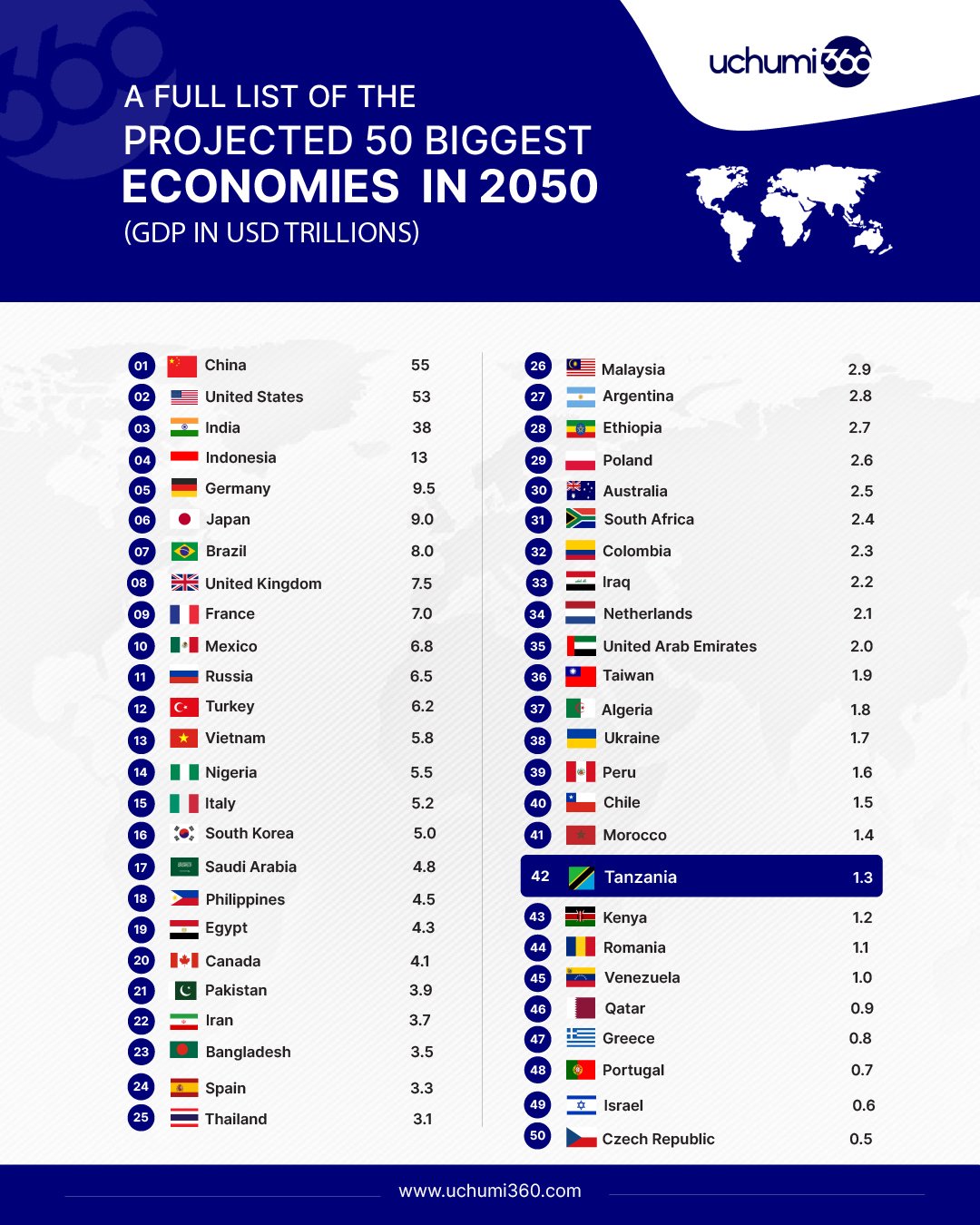Tanzania Set to Join the World’s Top 50 Economies by 2050 – Beating Kenya, Qatar, and More

The country’s economic engine is being fueled by multiple forces: vast natural resources, strong agricultural potential, gas and mineral exports, and rapid urbanization.
Tanzania is projected to rise into the world’s 50 largest economies by 2050, with an estimated GDP of 1.3 trillion US dollars. This growth would mark a historic transformation for a nation that today sits in the lower-middle-income bracket, positioning it ahead of countries such as Kenya, Qatar, Greece, Portugal, and Israel.
For decades, Tanzania has been seen as a country with untapped potential. Now, the numbers suggest that potential could turn into reality. With a fast-growing population expected to surpass 100 million by mid-century, Tanzania will command one of the youngest and most energetic labor forces in the world. Dar es Salaam, already East Africa’s commercial hub, is projected to become a megacity, driving industrial growth, investment, and cultural influence across the continent.
The country’s economic engine is being fueled by multiple forces: vast natural resources, strong agricultural potential, gas and mineral exports, and rapid urbanization. At the same time, Tanzania benefits from its strategic position within the East African Community, a regional bloc that is steadily expanding its global trade footprint.
Globally, the biggest economies in 2050 will still be dominated by giants like China, the United States, and India. But the real story lies in the new entrants. Tanzania’s rise is significant because it represents Africa’s shifting role in the global economy. Alongside Nigeria, Ethiopia, and Egypt, it is part of a new wave of African economies that will redefine the balance of power by mid-century.
Challenges remain. To reach its full potential, Tanzania must industrialize, improve education and skills training, modernize its infrastructure, and strengthen governance. The risk of inequality, corruption, and overdependence on raw exports still lingers. But if the right choices are made, Tanzania could emerge as a trillion-dollar powerhouse and a symbol of Africa’s economic awakening.
Here is a full list of the projected 50 biggest economies in 2050 (GDP in USD trillions):
- China – 55
- United States – 53
- India – 38
- Indonesia – 13
- Germany – 9.5
- Japan – 9.0
- Brazil – 8.0
- United Kingdom – 7.5
- France – 7.0
- Mexico – 6.8
- Russia – 6.5
- Turkey – 6.2
- Vietnam – 5.8
- Nigeria – 5.5
- Italy – 5.2
- South Korea – 5.0
- Saudi Arabia – 4.8
- Philippines – 4.5
- Egypt – 4.3
- Canada – 4.1
- Pakistan – 3.9
- Iran – 3.7
- Bangladesh – 3.5
- Spain – 3.3
- Thailand – 3.1
- Malaysia – 2.9
- Argentina – 2.8
- Ethiopia – 2.7
- Poland – 2.6
- Australia – 2.5
- South Africa – 2.4
- Colombia – 2.3
- Iraq – 2.2
- Netherlands – 2.1
- United Arab Emirates – 2.0
- Taiwan – 1.9
- Algeria – 1.8
- Ukraine – 1.7
- Peru – 1.6
- Chile – 1.5
- Morocco – 1.4
- Tanzania – 1.3
- Kenya – 1.2
- Romania – 1.1
- Venezuela – 1.0
- Qatar – 0.9
- Greece – 0.8
- Portugal – 0.7
- Israel – 0.6
- Czech Republic – 0.5
Tanzania’s position at number 42 may not seem extraordinary compared to giants like China or India, but it signals something bigger: the arrival of new players on the world economic stage. For a country that was once written off as poor and peripheral, becoming a trillion-dollar economy will be nothing short of revolutionary.
